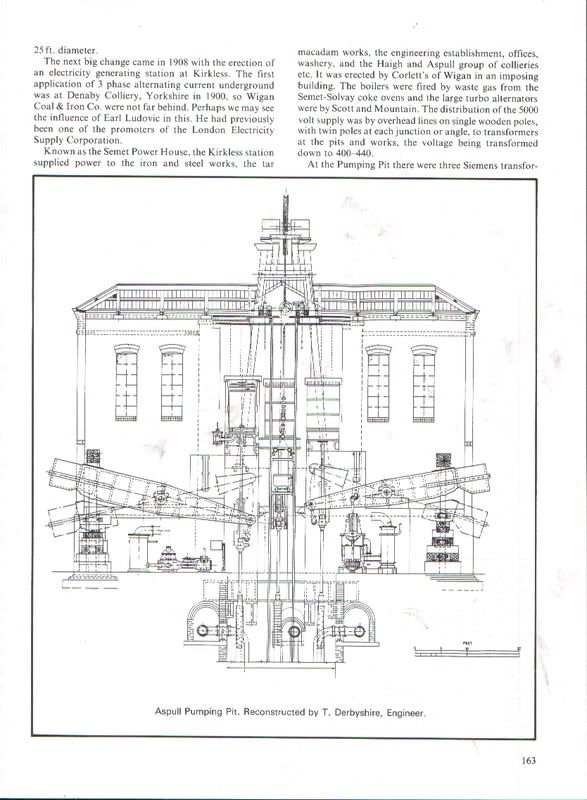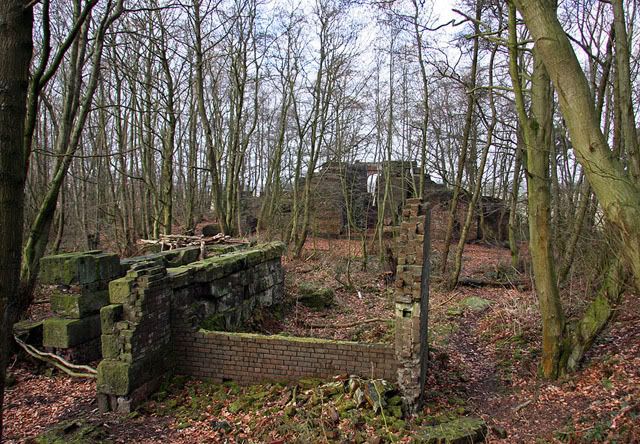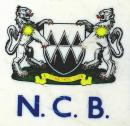 |
||||
| ||||
|
|||||||
| Underground Sewers, Culverts, Caves, Mines & Air raid shelters etc. |
 |
|
|
Thread Tools | Display Modes |
  ARCHIVE: Aspull Pumping Pit Jan 09 ARCHIVE: Aspull Pumping Pit Jan 09 |
|
(#1)
|
||||
|
||||
|
History taken from the Wigan Coalfield by Donald Anderson. Aspull Pumping Pit has been commenced at Aspull for the purpose of draining the Cannel and King Coal Mines and concentrating the several pumping establishments now at work for that purpose. This will be more efficient and more economical. By an agreement with W Woods & Son, and in consideration of an annual payment to the company (£500), the water from Wood’s Scot Lane Colliery will be pumped at this new pit. The pit shaft was 21ft diameter and a wagon road had been laid to it from the sidings at No5 Moor Pit. A waterway was constructed in the King Seam from Scot Lane Pits, past Woods No4 Cannel Pit to the new pump lodges in the King Coal at the pumping pit. In December 1872 it was stated that ‘the quantity of water has been greater than we anticipated’. Three large, direct acting steam engines with inverted cylinders were erected to work the 20-inch diameter ram pumps at this pit. The water in the Cannel was good clean water suitable for steam boilers and it was pumped to the surface by the ram worked from an offset on the spear rods. It was used for the locomotives and for the boilers at the pit. All three engines were fitted with condensers and the three pumps delivered through 16-inch diameter cast iron pipes against a vertical head (after the collapse of the sough tunnel) of approximately 180 yards. By December 1876 the whole job had been completed, including the engine houses, the winding, the capstan engine, the head frame, the gantries and all the boiler plant. The latter in 1895 consisted of 5 Lancashire boilers. A mining engineer with the Wigan Coal & Iron Company, Ernest Holt, said that these great pumping engines made a big noise when working, snorting, groaning and shaking everything when the pistons came to the end of their stroke. A report from Mr A Bertram, the Chief Engineer to Mr J Hilton, Head Surveyor and Mining Engineer, stated that for the year 1883 the 60 in engine had pumped 172,525,540 gallons from the King Coal and 63,847,219 gallons of clean water from the Cannel. Mr e Mawdesley formerly of the Coal Board, worked at the Pumping Pit as a boy and said the water from the Scot Lane area flowing past NO4 Pit to the underground pump lodges resembled a river in spate. In 1886 a problem arose with Park Hall or Arley Main Colliery, Blackrod. This had been worked for upwards of 20 years by Ridgeway & Co under Roger Leigh’s estate. By November 1885 the seams were becoming exhausted and Ridgeways gave notice determining the lease. Wigan Coal & Iron Co then decided to take over the colliery in order to continue working the pumps until an aqueduct had been constructed to convey Ridgeway’s water through Scot Lane workings to Aspull Pumping Pit. The make of water at Ridgeways was 210,000 gallons per day. They had worked to a fault under Red Moss at Horwich. This moss has been described as ‘notorious’. The waterway from Ridgeways to Scot Lane No5 to connect with that from Scot Lane to Aspull pumps was made under an agreement between Wigan Coal & Iron Co and Elias Dorning, part owner of Park Hall Estate. Two parallel roads 6ft wide were to be driven in the King Seam. Rock tunnels through a 10yd fault to Ridgeways pumping pit connected these. From Dorning’s estate the water ran downhill in roads in the King and along a tunnel through a 25yd fault near Scot Lane No1 shaft. Through the fault and exactly opposite was the Canel mine. The water was then led down the shaft from the Cannel mouthing in rectangular wooden spouts to a waterway running due south in the King Coal below. This ran past the Scot Lane No4 Cannel Pit, downhill into the underground lodges of the Aspull Pumping Pit. At the Pumping Pit there were three Siemens transformers in the sub-station building, a separate cable running from each of these to each pump underground.    Looking from what is left of the winding house to the pumping pit (coal was also wound from the pit)     Old brick lined culvert that runs beneath the old mineral line and spoil heaps of the little Cannel pit.  
Last edited by Morrisey; 30-01-2009 at 20:55. |
||||
  |
|
(#2)
|
||||
|
||||
|
Anybody local should really stick this on their to do list, an awe inspiring structure with the walls 8 brick thick supporting massive stone blocks. You could spend hours moochin round here.
The brick culvert is a delight & a return visit is on the agenda, we'd have done it today but theres a limit to how long you can stretch out going for a loaf & a pint of milk .         Aaaahhhh !!! my brain hurts      Playing out again! 
http://www.flickr.com/photos/boboilurbex/ http://boboil5.blogspot.com/ http://www.youtube.com/user/Boboil5 |
||||
  |
|
(#3)
|
||||
|
||||
|
Today I managed to get over to Aspull Pumping Pit myself and boy was it worth it. Fascinating remains and fun trying to tie in the brick and stonework with the plans from the Anderson and France book.
 A quick site overview  Found this outfall which I presume is the other end of the culvert featured in the original report.  A quick look into the culvert whilst I was there. |
||||
  |
|
(#4)
|
||||
|
||||
|
Donald Anderson scoured everywhere for a photo of the site and never found one, Tom Darbyshire worked the drawings up from memory, but he was an engineer and apparently had a detailed memory of the site having worked there. The archives of the engine makers may exist somewhere and if so there could be drawings of the complete setup.
Here's the 1893 25" OS map; 
|
||||
 |
| Bookmarks |
«
Previous Thread
|
Next Thread
»
| Currently Active Users Viewing This Thread: 1 (0 members and 1 guests) | |
| Thread Tools | |
| Display Modes | |
|
|
Powered by vBulletin® Version 3.8.6
Copyright ©2000 - 2024, Jelsoft Enterprises Ltd.
vBulletin Skin developed by: vBStyles.com
Copyright ©2000 - 2024, Jelsoft Enterprises Ltd.
vBulletin Skin developed by: vBStyles.com
© 2008-2015. Photographs and text are copyright and the property of the poster unless otherwise stated, and should not be used without express written permission.
Any opinions stated by users of this forum are NOT those of the site owners, each poster takes FULL responsibility for their own posts.
Any opinions stated by users of this forum are NOT those of the site owners, each poster takes FULL responsibility for their own posts.











 Linear Mode
Linear Mode
